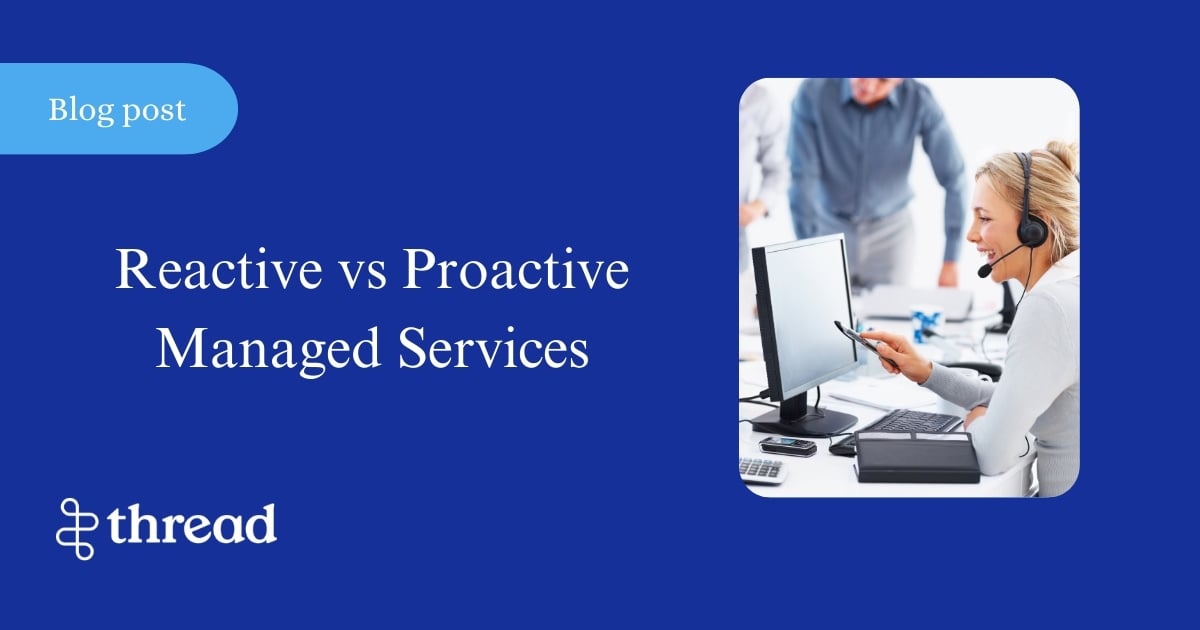MSP Pricing Models & Strategy Considerations
Discover 8 popular MSP pricing models, learn how to set your prices, and read pricing tips from industry professionals.

Managed services providers (MSPs) offer businesses a range of solutions to address their IT needs, but not all managed services are created equal. A proactive managed services provider optimizes its clients' productivity by anticipating problems before they occur. In contrast, a reactive IT support provider responds after a problem has already occurred.
The MSP business model is presumed to be proactive by definition. However, some are more proactive than others. Efficient and reliable IT services are crucial for business success. That's why working with an MSP that offers proactive support is generally the best long-term solution.
A reactive IT service provider responds to clients' IT issues as they arise. This approach is often characterized by a "break-fix" model, in which the provider waits for customers to report problems and then takes action to resolve them.
Reactive IT providers are characterized by the following features:
While reactive IT services may be suitable for organizations that don’t rely too much on technology, they are not the best option for businesses that are computer-based and require proactive IT management to ensure their continued operation.
A proactive managed service provider (MSP) takes a preventative approach to IT management, anticipating and addressing potential issues before they occur. Their proactive approach involves continuous monitoring, maintenance, and optimization of IT systems to ensure optimal performance and minimize downtime.
Proactive managed services providers have the following characteristics:
The best proactive MSPs should offer the following features to support your business.
Ask prospective MSPs about the systems they have in place for the following:
Remote monitoring aims to prevent network failures, improve security, and facilitate data-driven decision-making. This basic function is essential for proactive problem-solving as it allows MSPs to identify and address issues before they escalate into major problems. This capability also offers cost efficiency as it reduces the need for on-site visits.
These practices help to protect businesses from legal, financial, and reputational risks, while ensuring adherence to industry standards and regulations. Robust risk management practices help to protect sensitive customer data from breaches and unauthorized access. This in turn helps businesses recover quickly from incidents and minimizes disruptions.
Patch management is the process of applying software updates, security patches, and bug fixes to IT systems and applications. It is a critical aspect of IT maintenance and security, as it helps to address vulnerabilities, improve performance, and ensure compliance with industry standards.
Research suggests that more than 50% of companies are unable to patch critical vulnerabilities within the 72-hour recommended time. 15% of them are still unpatched after 30 days, representing a significant security risk. Ask prospective MSPs which services they offer to prevent problems before they occur and avoid putting your business at risk.
A quality proactive MSP will meet you where you are rather than asking you to adopt separate communication channels. MSPs that use Thread can chat with your team members and open tickets (or “threads”) right from the communication platform your business already uses, such as Microsoft Teams or Slack.
The chatbot powered by Magic AIautomatically connects you with the best technician for the job for the fastest response and resolution times. Thread also prioritizes urgent user requests, ensuring problems that impact critical operations and productivity are solved in a timely manner.
|
REACTIVE |
PROACTIVE |
|
|
RESPONSE TIME |
Slower response times as they react to problems after they occur. |
Faster response times, especially if your MSP integrates effective communication platforms. |
|
PRODUCTIVITY AND PERFORMANCE |
Productivity and performance can be significantly impacted by downtime and bottlenecks while waiting for the service provider to solve the problem. |
Proactive monitoring and maintenance helps to prevent outages, minimize downtime, and improve performance and efficiency. |
|
SECURITY |
Relying solely on reactive support can increase the risk of security breaches, data loss, and operational disruptions. |
Proactive security measures help protect against cyber threats and data breaches. |
|
OPTIMIZATION OF IT SYSTEMS |
Reactive service providers may not focus on optimizing IT systems and processes, potentially leading to inefficiencies. |
Advanced tracking and analytics allow proactive MSPs to optimize the efficiency of client systems. |
|
COST |
Lower upfront cost but potentially higher long-term expense. |
Proactive MSPs help reduce long-term costs associated with emergency repairs and data recovery by preventing issues before they occur. |
|
COMPLEXITY |
Little client oversight required. |
Managing a proactive MSP relationship may require more involvement and oversight from the client. |
|
CUSTOMIZED SOLUTIONS |
Little scope for customized solutions. |
Proactive MSPs can tailor their services to meet the specific needs and goals of each client. |
Proactive MSPs offer a balance of services and technical support that help companies optimize productivity and reach their business goals. Choosing a proactive MSP with the best integrations is recommended for businesses with aspirations for success.
Understandably, some small businesses with a limited IT budget may opt for a reactive IT service provider at the beginning of their journey. However, switching to a proactive service provider will be a significant step along the road to business growth.
Discover 8 popular MSP pricing models, learn how to set your prices, and read pricing tips from industry professionals.
Learn IT cost reduction strategies that focus on optimizing ROI from your IT services without creating costly problems or long-term losses.
Familiarize yourself with MSP profit margin formulas, industry standards, and strategic ways to improve by reducing costs and increasing revenue.
Sign up for our newsletter to get the latest and greatest delivered directly to your inbox by Aerosmith. just kidding, it's us, and the newsletter is awesome.